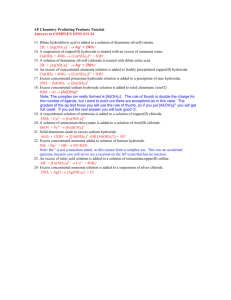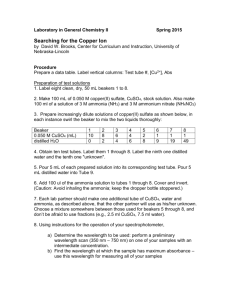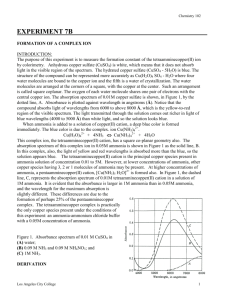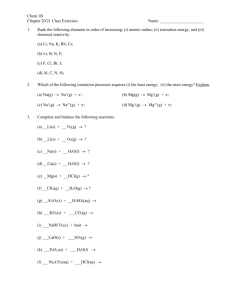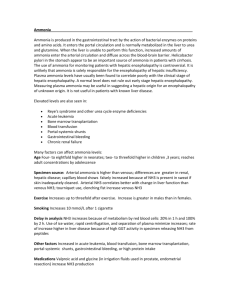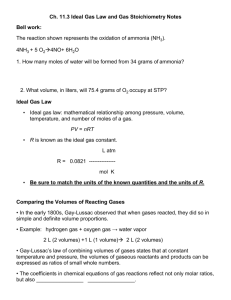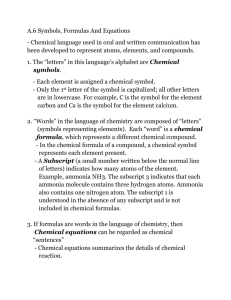EXPERIMENT 9 - Los Angeles City College
advertisement
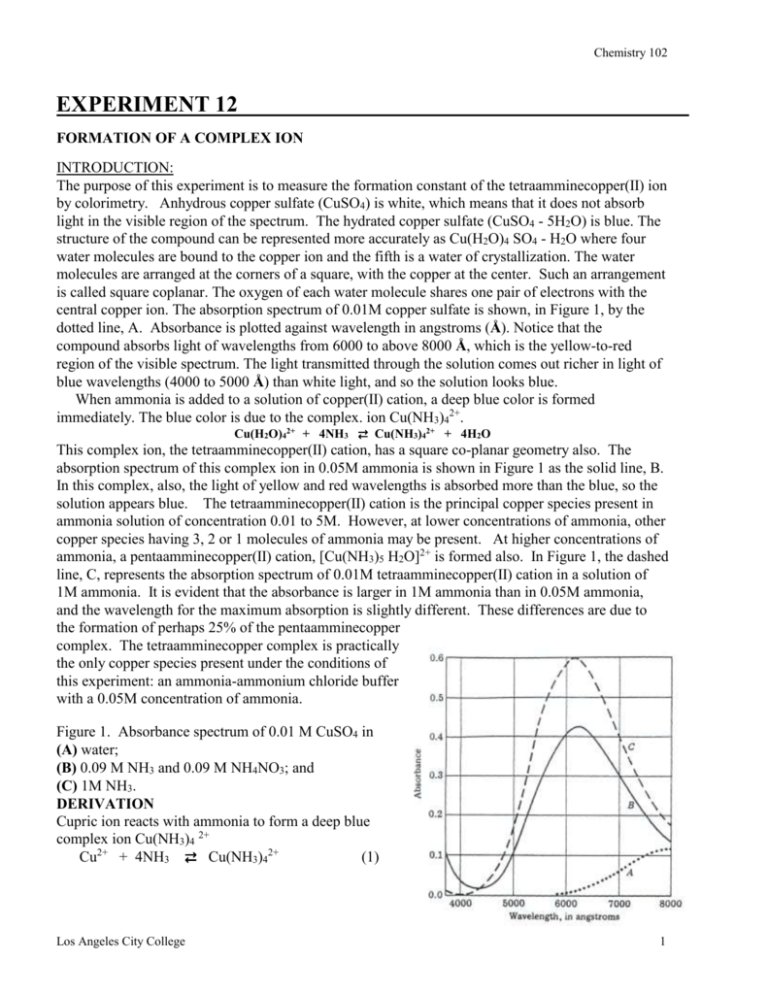
Chemistry 102 EXPERIMENT 12 FORMATION OF A COMPLEX ION INTRODUCTION: The purpose of this experiment is to measure the formation constant of the tetraamminecopper(II) ion by colorimetry. Anhydrous copper sulfate (CuSO4) is white, which means that it does not absorb light in the visible region of the spectrum. The hydrated copper sulfate (CuSO4 - 5H2O) is blue. The structure of the compound can be represented more accurately as Cu(H2O)4 SO4 - H2O where four water molecules are bound to the copper ion and the fifth is a water of crystallization. The water molecules are arranged at the corners of a square, with the copper at the center. Such an arrangement is called square coplanar. The oxygen of each water molecule shares one pair of electrons with the central copper ion. The absorption spectrum of 0.01M copper sulfate is shown, in Figure 1, by the dotted line, A. Absorbance is plotted against wavelength in angstroms (Å). Notice that the compound absorbs light of wavelengths from 6000 to above 8000 Å, which is the yellow-to-red region of the visible spectrum. The light transmitted through the solution comes out richer in light of blue wavelengths (4000 to 5000 Å) than white light, and so the solution looks blue. When ammonia is added to a solution of copper(II) cation, a deep blue color is formed immediately. The blue color is due to the complex. ion Cu(NH3)42+. Cu(H2O)42+ + 4NH3 ⇄ Cu(NH3)42+ + 4H2O This complex ion, the tetraamminecopper(II) cation, has a square co-planar geometry also. The absorption spectrum of this complex ion in 0.05M ammonia is shown in Figure 1 as the solid line, B. In this complex, also, the light of yellow and red wavelengths is absorbed more than the blue, so the solution appears blue. The tetraamminecopper(II) cation is the principal copper species present in ammonia solution of concentration 0.01 to 5M. However, at lower concentrations of ammonia, other copper species having 3, 2 or 1 molecules of ammonia may be present. At higher concentrations of ammonia, a pentaamminecopper(II) cation, [Cu(NH3)5 H2O]2+ is formed also. In Figure 1, the dashed line, C, represents the absorption spectrum of 0.01M tetraamminecopper(II) cation in a solution of 1M ammonia. It is evident that the absorbance is larger in 1M ammonia than in 0.05M ammonia, and the wavelength for the maximum absorption is slightly different. These differences are due to the formation of perhaps 25% of the pentaamminecopper complex. The tetraamminecopper complex is practically the only copper species present under the conditions of this experiment: an ammonia-ammonium chloride buffer with a 0.05M concentration of ammonia. Figure 1. Absorbance spectrum of 0.01 M CuSO4 in (A) water; (B) 0.09 M NH3 and 0.09 M NH4NO3; and (C) 1M NH3. DERIVATION Cupric ion reacts with ammonia to form a deep blue complex ion Cu(NH3)4 2+ Cu2+ + 4NH3 ⇄ Cu(NH3)42+ (1) Los Angeles City College 1 Chemistry 102 The mass action expression for this equilibrium can be written as follows; K, is the formation constant of the tetraamminecopper(II) ion: Kf = [Cu(NH3)42+] [Cu2+] [NH3]4 The equilibrium for Reaction (1) lies very far on the side of the complex ion; so far that the cupric ion concentration is too small to measure, except by an electrochemical cell. In this experiment, the formation constant will be measured by studying the equilibrium between solid copper hydroxide and cupric ammine complex in ammonia. When cupric hydroxide is treated with ammonia, one expects the reaction Cu(OH)2 (s) + 4NH3 ⇄ Cu(NH3)42+ + 2OH(2) The concentration of the cupric ammine can be estimated from the color of the solution. The hydroxide ion concentration should be twice as great. The situation is not, however, so simple. The pH of the solution is less than that expected on the basis of Reaction (2), probably because of the acidity of the cupric ammine ion, which contains two water ligands. [Cu(NH3)4(H2O)2]2+ + OH- ⇄ [Cu(NH3)4(H2O)(OH)]+ + H2O (3) The difficulty can be avoided if the solution is buffered to a known pH in the moderately alkaline range. This is accomplished most directly by treating the cupric hydroxide with an equimolar mixture of ammonia and ammonium nitrate thus neutralizing the hydroxide ion. Cu(OH)2 (s) + 2NH3 + 2NH4+ ⇄ Cu(NH3)42+ + 2H2O (4) The concentrations of ammonia and ammonium ion remain equal, since they are consumed equally, and the pOH of the solution remains buffered at 4.75, the pKb of the ammonia. The mass action expression for Equation (4) can be written K = [Cu(NH3)42+ ] [H2O]2 [Cu(OH)2 ]s [NH3]2 [NH4+]2 but since the water concentration is essentially constant in water solution, and because cupric hydroxide is a solid, the expression can be written K4 = [Cu(NH3)42+] [NH3]2 [NH4+]2 It can be shown that K4 = Kf Ksp / Kb2 by combining the following equilibria with the mass action equation for formation of the cupric ammine complex (4) with (I) Cu(OH)2 (s) ⇄ Cu2+ + 2OH thus Ksp = [Cu2+] [OH- ]2 (II) NH3 + H2O NH4+ + OH_ [Cu(NH3)42+]_ [Cu2+] [NH3]4 x [Cu2+] [OH-]2 Kb = [NH4+] [OH-] [NH3] 2 x ____[NH3] ___ [NH4+]2 [OH-]2 thus = Kf x Ksp x 1/Kb2 Los Angeles City College 2 Chemistry 102 _ [Cu(NH3)42+]_ = [NH4+]2 [NH4+]2 which is the mass action expression for Reaction (4). Canceling terms gives Kf Ksp Kb2 Procedure: Using a photometric colorimeter The first order decay law appears again in Lambert’s and Beer's laws, which relate the light incident on a homogeneous medium to the light transmitted. If the light that is reflected is ignored, the incident light intensity, Io , equals the intensity absorbed and the intensity transmitted Io = Ia + It Lambert's (or Bouguer's) law considers only the thickness of the medium. The incident light falling on a film of thickness dl of absorbing substance decreases in intensity -dI. The "rate" of decrease is proportional to the intensity - dI / dl = k I Integration gives -ln I = k l + C C is ln Io, since I = Io when l = 0 -In I + ln Io = k l therefore ln Io / I = kl The constant k was called the extinction coefficient, , by Bunsen and Roscoe, and it is a property of the absorbing material. Beer's law relates absorption to concentration, c, of the absorbing substance as follows: -dI / dc = k’ I Integration gives ln Io / I = k’ c Combining both laws would give ln Io / I = lc or 2.3 log (Io / I) = lc If you do not understand the calculus derivation, do not worry about it. You can utilize the relationship given below even if you do not follow its derivation. The quantity (I / Io) x 100 is called the percent transmission, %T. The quantity log (Io / I) is called the absorbance, A. A = log (Io / I) = log (100 / %T) = ( lc / 2.3) A graph of A versus c should give a straight line if the path length, l, is constant. The slope of the line is l/2.3. This equation is developed for monochromatic light, that is, light of a single wavelength. Consequently, in practice we usually make a calibration curve, which may deviate from a straight line somewhat, since we may not be using monochromatic light and because of instrument peculiarities. Los Angeles City College 3 Chemistry 102 A photoelectric colorimeter uses a photocell with a galvanometer to measure the transmitted light. The intensity transmitted by a solution of absorbing compound is compared to the intensity of light transmitted by the cell containing only solvent (usually water). The best wavelength to use for measuring the concentration would be the wavelength for which the absorbance can change most for a change in concentration. Consequently, a wavelength near the maximum at 6200 Å or 620 nm (nanometers) should be chosen (see Figure 1). In the case of colorimeters that use filters, a red filter should be used. The instructor will demonstrate the operation of the photoelectric colorimeter. Follow instructions. This is an expensive instrument. Do not spill chemicals on the instrument. PROCEDURE: Calibration curve Make solutions that are 0.025, 0.020, 0.010, 0.005, and 0.002M in cupric ammine complex from the volumes listed in Table 1 of 0.10M CuSO4, 0.010M CuSO4 (made by 1:10 dilution of 0.10M CuSO4), a solution that is 0.50M NH3 and 0.50M NH4NO3, and water. The NH3-NH4NO3 is made by mixing 10 mL of 1.0M NH3 with 10 mL of 1.0M NH4NO3. Line up five 18- x 150-mm test tubes in a test tube rack. Number them 1 to 5. Using a 5-mL Mohr pipette, measure 2.5 mL, 2.0 mL, and 1.0 mL of 0.10M CuSO4 into Tubes 1, 2, and 3. After rinsing the Mohr pipette with 0.010M CuSO4, add the amounts listed in Table 1 to Tubes 4 and 5. Rinse the pipette with water and then with NH3NH4NO3 solution before adding the listed volumes to the tubes. Rinse the pipette with water well, and add the listed volumes of water to the tubes. Shake each tube. Using the colorimeter, measure the absorbance (A) of the samples. If the instrument reads in percent transmission (%T), convert this to A. Make a graph of absorbance versus concentration of copper amine complex. Draw a smooth curve through the points. The graph should be very nearly a straight line. Table 1 Complex concentration 0.10 M CuSO4 0.01M CuSO4 0.5M NH30.5M NH4NO3 Distilled water No. 1 0.025 M No. 2 0.020 M No. 3 0.010 M No. 4 0.005 M No. 5 0.002 M 2.5 mL 2.0 mL 1.0 mL 0.0 mL 0.0 mL 0.0 mL 0.0 mL 0.0 mL 5.0 mL 2.0 mL 3.0 mL 2.6 mL 1.8 mL 1.4 mL 1.2 mL 4.5 mL 5.4 mL 7.2 mL 3.6 mL 6.9 mL Measuring the equilibrium Using a pipette, mix 5 mL of 1.0 M aqueous ammonia and 5 mL of 1.0 M aqueous ammonium nitrate with 15 mL of distilled water, making a solution that is 0.2M in NH3 and 0.2M in NH4NO3. Four 0.25-millimole samples of cupric hydroxide are prepared as follows. Into each of four clean 13 X 100-mm test tubes place 2.5 mL of 0.1M CuCl2 followed by 3.0 mL of 0.2M sodium hydroxide. Stopper the test tubes, shake well, and centrifuge. Decant the liquid. Fill each tube half full (keep Los Angeles City College 4 Chemistry 102 the level the same in each) with distilled water, stopper, shake, and centrifuge. Decant the wash water. Number the tubes 1, 2, 3, and 4. Using a 5-mL graduated Mohr pipette add the following solutions exactly as directed, ----add 3.0 mL of the NH3-NH4NO3 solution, which is 0.2M in NH4NO3, to Tube 1. ----add 2.0 mL of the 0.2M solution to Tube 2, ----add 1.0 mL of the 0.2M solution to Tube 3, ----and add 0.5 mL of the 0.2M solution to Tube 4. Then, after rinsing the pipette, ----add 2.0 mL of distilled water to Tube 1 ----add 3.0 mL of distilled water to Tube 2, ----add 4.0 mL of distilled water to Tube 3, ----and add 4.5 mL of distilled water to Tube 4. Each tube will have a 5-mL volume of solution. The concentrations of ammonia (or ammonium nitrate) in the tubes, assuming no reaction, [NH3]o, are 0.12M, 0.08M, 0.04M, and 0.02M, respectively. Cork and shake the tube for two minutes. Then centrifuge the tubes (with parafilm on to prevent dirt from falling into them). Observe the color intensities and record the relative intensities of blue color (most, second, third, least), and whether a precipitate of copper hydroxide remains. Discard any tube that does not contain a precipitate. Decant the solution from a test tube into a tube for use in the photoelectric colorimeter. Measure the absorbance of the solution with the instrument. Do the same with the other solutions. Taking these absorbances (A), read the concentrations of copper amine complex from your calibration graph. Equipment & Chemicals Colorimeter Centrifuge with head for 100-mm test tubes One 5-mL Mohr graduated pipette 10 mL 0.1 M Copper sulfate One transfer pipette bulb 10 mL 1M Ammonia Five 18 x 150-mm test tubes 10 mL 1M Ammonium nitrate Four 13 x 100-mm test tubes with corks 10 mL 0.1M Copper chloride One 10-mL graduated cylinder 12 mL 0.2M Sodium hydroxide Time requirement: Two hours Los Angeles City College 5 Chemistry 102 NAME_____________________________________ SECTION _______ REPORT SHEET EXPERIMENT 12 Formation of a Complex Ion CALCULATIONS (in your notebook, show only a sample calculation for each type here): 1. Compute what the concentration of ammonia would have been if there had been no reaction with cupric hydroxide, [NH3]o. The concentration of ammonium ion is the same (given above). 2. Determine the concentration of the cupric amine complex ion from the colorimeter calibration graph. 3. Assuming the stoichiometry of Reaction (4), compute the concentration of ammonia left. Notice that two ammonia molecules and two ammonium ions are used to form each tetraamminecopper(II) cation. Therefore: [NH3]eq = [NH4+]eq = [NH3]o - 2[Cu(NH3)42+] Los Angeles City College 6 Chemistry 102 4. For each tube, compute the value of K4 and decide if, within the precision of the experiment, it is a constant. 5. Combine the average of the above K4's with the value of the solubility product of cupric hydroxide and the dissociation constant for ammonia; compute the value of the formation constant of tetraamminecopper(II), Kf. QUESTIONS: 1. Compare the average Kf value from this experiment to the Kf obtained from the electrochemical experiment. Which method was more accurate? 2. When ammonia is added to an aqueous solution of copper ions, what happens? Explain what is observed with a balanced equation. Los Angeles City College 7 Chemistry 102 3. According to Beer’s law, what relationship exists between the absorbance, A, and the concentration of the absorbing substance in the solution? 4. Calculate the extinction coefficient at the maximum absorbance ( max) for the tetraamminecopper cation if the cells used in figure 1 had a 1-cm pathlength. Los Angeles City College 8
